The culinary landscape of Northern Iran might have missed one of its most iconic dishes, Mirza Ghasemi, had it not been for Mirza Mohammad Qasem Khan Qajar, a former governor of Rasht. This flavorful Gilani specialty, while not inherently high in calories, can be prepared with an emphasis on health, closely following the authentic regional method.
This article from Foodex magazine will guide you through various ways to prepare Mirza Ghasemi, including traditional stovetop methods, oven-based approaches, versions for special occasions, and even a variation without tomatoes. Let’s explore the classic preparation first.
Classic Mirza Ghasemi Recipe (Stovetop Method)
Preparation and Cooking Time: Approximately 1 hour
Servings: 5
| Ingredients | Quantity |
| Eggplant | 1 kg |
| Tomatoes | 1 kg |
| Eggs | 3 |
| Tomato Paste | 1 tbsp |
| Garlic | 7 cloves |
| Turmeric, Salt, and Pepper | to taste |
| Oil | as needed (minimal amount recommended for a lighter version) |
Instructions
Prepare the Eggplants: The traditional method for Mirza Ghasemi involves charring the eggplants over an open flame or charcoal to impart a distinctive smoky flavor. Alternatively, for convenience or a less smoky taste, you can grill them, roast them in the oven, or even boil them (though boiling will result in a milder flavor and different texture, often preferred by those on a strict diet). Once cooked and tender, allow the eggplants to cool slightly, then peel off the skin.
Prepare Tomatoes and Garlic: Dice half of the tomatoes and grate the other half. Finely chop or crush the garlic cloves.
Sauté Aromatics and Tomatoes: Heat a minimal amount of oil in a suitable frying pan over medium heat. Add the chopped garlic and sauté until fragrant (be careful not to burn it). Stir in the tomato paste and spices (turmeric, salt, pepper), mixing well. Add both the diced and grated tomatoes to the pan. Cook, stirring occasionally, until the excess water from the tomatoes has evaporated and the sauce has thickened. Remove the tomato sauce from the heat and set aside.
Cook the Eggplant: Chop the peeled eggplants. In the same or a separate frying pan, heat a very small amount of oil and sauté the chopped eggplants until they are soft and slightly mashed.
Combine and Simmer: Add the prepared tomato sauce back to the pan with the sautéed eggplants. Mix thoroughly. Allow the mixture to simmer gently for about 10-15 minutes, stirring occasionally, to allow the flavors to meld.
Add Eggs: Create wells in the eggplant and tomato mixture and crack the eggs directly into them. Alternatively, lightly beat the eggs in a separate bowl and then pour them over the mixture. Gently mix the eggs into the eggplant and tomato, cooking until the eggs are set to your preference.
Serve: After approximately 5 more minutes of cooking, your Mirza Ghasemi is ready. It is traditionally served warm, often accompanied by fresh Barbari bread or other local breads. For an appetizer presentation, consider serving it with garlic bread.
Mirza Ghasemi in the Oven: A Convenient Alternative
While charring eggplants over an open flame imparts an unparalleled smoky depth, utilizing an oven is a highly practical alternative, especially in modern apartment settings. This method yields a delicious Mirza Ghasemi with minimal fuss.
Preparation and Cooking Time: Approximately 50-60 minutes
Servings: 2-3
| Ingredients | Quantity |
| Eggplants (approximately 500-600g) | 2 large |
| Ripe Tomato (or 2 medium) | 1 large |
| Tomato Paste | 1 tbsp |
| Eggs (to preference) | 1-2 |
| Garlic, minced | 2-3 cloves |
| Turmeric, Salt, and Black Pepper | to taste |
| Olive Oil or Vegetable Oil | 1-2 tablespoons |
Instructions
Roast the Eggplants: Preheat your oven to 200C (400F).
Wash and dry the eggplants. Prick the skins in several places with a fork (this prevents them from bursting). Place them on a baking tray lined with parchment paper and roast for 30-40 minutes, turning them occasionally, until the skin is blistered and the flesh is very tender.
Expert Tip: For a hint of smokiness even in the oven, you can briefly broil the eggplants for the last 5 minutes of cooking, keeping a close eye on them to prevent burning.
Cool and Peel Eggplants: Remove the eggplants from the oven and let them cool for a few minutes until they are manageable to handle. The skin should peel off easily. Scoop out the flesh and mash it coarsely with a fork or chop it.
Prepare Tomato Base: While the eggplants are cooling, you can prepare the tomato base. Grate the tomato (or finely dice it). Heat the oil in a pan over medium heat. Add the minced garlic and sauté for about a minute until fragrant, being careful not to brown it excessively. Stir in the tomato paste, turmeric, salt, and pepper. Add the grated/diced tomato and cook, stirring occasionally, until the mixture has thickened and some of the moisture has evaporated (about 5-7 minutes).
Combine and Simmer: Add the mashed or chopped roasted eggplant to the tomato mixture in the pan. Stir well to combine. Reduce the heat to low, cover the pan, and let the ingredients simmer together for 10-15 minutes, allowing the flavors to meld beautifully. Stir periodically.
Incorporate Eggs: As with the stovetop method, you can either crack the eggs directly into wells made in the mixture or lightly beat them and pour over. Gently stir to incorporate the eggs and cook until they are set to your liking.
Serve: Garnish as desired (e.g., with a drizzle of good quality olive oil or fresh herbs like parsley if you wish, though not strictly traditional) and serve hot with your choice of bread.
Variations and Enhancements: Tailoring Mirza Ghasemi to Your Palate
The beauty of dishes like Mirza Ghasemi lies in their adaptability. Here are a few recognized variations and expert suggestions:
The “No Tomato” Version (Mirza Ghasemi Bedoon-e Gojeh Farangi)
For individuals with tomato sensitivities or those who prefer a different flavor profile, Mirza Ghasemi can be prepared without fresh tomatoes. In this variation, increase the amount of high-quality tomato paste slightly (perhaps 1.5-2 tablespoons for the classic recipe proportions) to provide color and umami. Ensure the paste is well sautéed with the garlic to cook out any raw taste. Some purists might even omit tomato products altogether, focusing solely on the smoky eggplant and garlic, though this is less common.
Foodex Insight: While tomatoes add acidity and sweetness, a tomato-less version highlights the earthy notes of eggplant and the pungency of garlic more directly.
Embracing the Smoke: The Traditional Grilling Method
As mentioned in the classic recipe, the most authentic flavor comes from grilling eggplants directly over charcoal or a gas flame until the skin is thoroughly charred and the flesh is meltingly tender. This technique, central to the “Northern-style” (Shomali) Mirza Ghasemi, infuses the dish with an irreplaceable smoky aroma. If you have the facilities, this method is highly recommended for the quintessential experience.
Did you know? The specific aromatic compounds developed during charring are key to the signature taste of many traditional Middle Eastern and Mediterranean eggplant dishes. Explore more about traditional cooking techniques in our [Link to relevant category/article on Foodex about cooking techniques].
A Touch of Richness: Mirza Ghasemi with Walnuts (Mirza Ghasemi ba Gerdoo)
While not part of the original Gilani recipe, some enjoy the addition of finely chopped or ground walnuts. Walnuts can introduce a pleasant textural contrast and a nutty richness. If using, add them towards the end of the simmering process or sprinkle on top as a garnish. Use fresh, high-quality walnuts to avoid any bitterness.
Consideration: Walnuts will increase the caloric density of the dish but also add beneficial fats and nutrients.
Garnishing and Presentation for a “Restaurant-Style” Finish
To elevate the presentation, especially when serving guests, consider frying a whole egg separately (sunny-side up or over easy) and placing it atop the Mirza Ghasemi just before serving. A sprinkle of fresh, finely chopped parsley or a few artfully placed basil leaves can also add visual appeal, though traditional Gilani presentations are typically minimalist.
Persian Festive Foods: From Nowruz to Other Events
Learn MoreFinal Words: Embracing a Culinary Gem from Iran
Mirza Ghasemi is more than just a recipe; it’s a vibrant expression of Gilani culinary heritage, a testament to how simple, fresh ingredients can be transformed into a dish bursting with flavor and character. From the deep, smoky notes of the traditional char-grilled preparation to the convenient oven-baked version and the various delightful adaptations, this dish offers a versatile and satisfying experience for any palate.
At Foodex, we believe in exploring and celebrating the rich tapestry of global food culture, and Mirza Ghasemi stands as a shining example of the ingenuity found in regional Iranian cuisine. We encourage you to embrace the methods shared, experiment with the variations, and make this iconic dish your own.
To discover more authentic recipes, in-depth culinary guides, and insights into the world of food, we invite you to explore the Persian Cuisine on Foodex Magazine. Happy cooking!
Frequently Asked Questions (FAQ) about Mirza Ghasemi
1- What is the best type of eggplant to use for Mirza Ghasemi?
For Mirza Ghasemi, Italian eggplants or globe eggplants are commonly used and work very well. Look for eggplants that are firm, heavy for their size, and have smooth, glossy skin. Younger, medium-sized eggplants tend to have fewer seeds and a less bitter taste. The key is to ensure they can be cooked until very tender to achieve the characteristic creamy texture.
2- Can I prepare Mirza Ghasemi ahead of time?
Yes, Mirza Ghasemi can be prepared a day or two in advance. In fact, many believe its flavor improves as it rests and the ingredients meld further. Store it in an airtight container in the refrigerator. Reheat gently on the stovetop over low heat, stirring occasionally, or in the microwave. You may need to add a tablespoon or two of water if it has thickened too much upon reheating. It’s best to add freshly cooked eggs if you prefer them runny or specifically for garnish just before serving the reheated dish.
3- How can I make Mirza Ghasemi vegan?
Making Mirza Ghasemi vegan is straightforward. Simply omit the eggs. The dish will still be delicious, focusing on the rich flavors of smoked or roasted eggplant, tomatoes, and garlic. Some choose to add a little extra olive oil for richness or even a sprinkle of nutritional yeast for a savory, umami note, though this is not traditional.
4- My Mirza Ghasemi tastes a bit too acidic or tart. How can I balance the flavor?
If your tomatoes are particularly acidic, or if the tomato paste lends too much tartness, you can balance the flavor by adding a pinch of sugar (about 1/4 to 1/2 teaspoon) to the tomato sauce while it’s simmering. Taste and adjust as needed. Ensure the tomatoes are well-cooked down, as this also helps to mellow their acidity and concentrate their sweetness.
5- Besides Barbari bread, what are other suitable accompaniments for Mirza Ghasemi?
While Barbari bread is a classic pairing, Mirza Ghasemi is wonderful with other Iranian breads like Sangak (a whole wheat sourdough flatbread) or Lavash. It can also be enjoyed with pita bread, toasted sourdough, or even as a hearty dip with sturdy crackers or vegetable sticks. In Gilan, it’s sometimes served alongside Kateh (Persian sticky rice) as part of a larger meal.






















